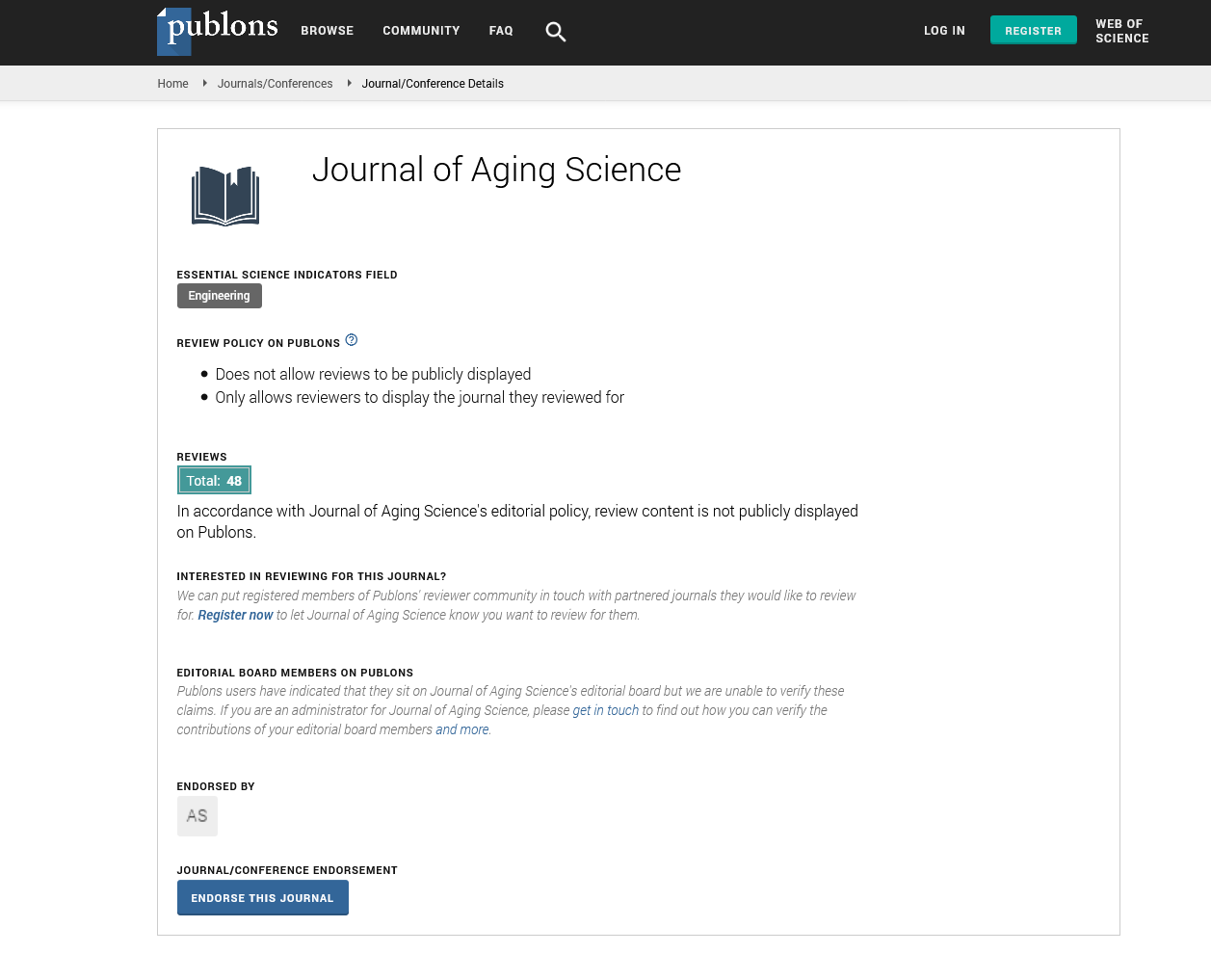Indexed In
- Open J Gate
- Academic Keys
- JournalTOCs
- ResearchBible
- RefSeek
- Hamdard University
- EBSCO A-Z
- OCLC- WorldCat
- Publons
- Geneva Foundation for Medical Education and Research
- Euro Pub
- Google Scholar
Useful Links
Share This Page
Journal Flyer

Open Access Journals
- Agri and Aquaculture
- Biochemistry
- Bioinformatics & Systems Biology
- Business & Management
- Chemistry
- Clinical Sciences
- Engineering
- Food & Nutrition
- General Science
- Genetics & Molecular Biology
- Immunology & Microbiology
- Medical Sciences
- Neuroscience & Psychology
- Nursing & Health Care
- Pharmaceutical Sciences
Opinion Article - (2025) Volume 13, Issue 2
The Gut-Brain Axis in Aging and Neurodegenerative Diseases
Luke Wilson*Received: 28-Mar-2025, Manuscript No. JASC-25-28629; Editor assigned: 31-Mar-2025, Pre QC No. JASC-25-28629 (PQ); Reviewed: 07-Apr-2025, QC No. JASC-25-28629; Revised: 14-Apr-2025, Manuscript No. JASC-25-28629 (R); Published: 28-Apr-2025, DOI: 10.35248/2329-8847.25.13.413
Description
The Gut-Brain Axis (GBA) is a bidirectional communication network linking the Gastrointestinal (GI) tract and the Central Nervous System (CNS). This complex system involves neural, hormonal, metabolic and immune pathways, with the gut microbiota playing an important role in modulating brain function.
As individuals age, changes in gut microbiota composition can contribute to neurodegenerative processes, increasing the risk of disorders such as Alzheimer’s Disease (AD), Parkinson’s Disease (PD) and other age-related cognitive impairments. Understanding the exchange between the gut and brain in aging can provide valuable insights into novel therapeutic strategies for preventing or slowing neurodegeneration.
The gut-brain axis: An overview
The GBA consists of several key components that facilitate communication between the gut and the brain: Neural pathways: The vagus nerve is a primary conduit that transmits signals between the gut and the brain, influencing mood, cognition and autonomic functions.
Endocrine system: Gut-derived hormones, such as ghrelin and leptin, regulate metabolic processes and impact brain function.
Immune system: The Gut-Associated Lymphoid Tissue (GALT) plays an important role in immune regulation, affecting neuroinflammatory processes.
Gut microbiota: The trillions of microorganisms residing in the gut produce metabolites that influence neurotransmission, inflammation and neuroprotection.
As aging progresses, dysregulation of these components can disrupt gut-brain communication, contributing to neurodegenerative diseases.
Aging and gut microbiota changes
Aging is associated with significant alterations in gut microbiota composition, a phenomenon known as gut dysbiosis. Keychanges include:
Reduced microbial diversity: The aging gut exhibits a decline in beneficial bacteria, such as Bifidobacteria and Lactobacilli, while harmful bacteria, such as Proteobacteria, may increase.
Increased intestinal permeability: A weakened intestinal barrier allows harmful substances, such as bacterial endotoxins (e.g., lipopolysaccharides or LPS), to enter the bloodstream and trigger systemic inflammation.
Chronic low-grade inflammation: Known as “inflammaging,” this persistent inflammatory state is linked to cognitive decline and neurodegeneration.
The combination of gut dysbiosis and immune dysregulation in aging individuals contributes to neurodegenerative disease development.
The gut-brain axis and neurodegenerative diseases
Alzheimer’s Disease (AD): Alzheimer’s disease is the most common form of dementia, characterized by Amyloid-beta (Aβ) plaque accumulation, tau protein tangles and neuroinflammation. Emerging evidence suggests that gut microbiota may influence AD progression through several mechanisms:
Inflammation and neurotoxicity: Increased levels of gut-derived endotoxins, such as LPS, promote neuroinflammation and contribute to amyloid plaque formation.
Short-Chain Fatty Acids (SCFAs): Beneficial gut bacteria produce SCFAs, such as butyrate, which have anti-inflammatory and neuroprotective effects. In AD patients, SCFA levels are often reduced, leading to increased neuroinflammation.
Microbiota influence on amyloid deposition: Studies in animal models show that germ-free mice (lacking gut microbiota) exhibit altered amyloid deposition patterns, highlighting a connection between gut bacteria and AD pathology.
Parkinson’s Disease (PD): Parkinson’s disease is a neurodegenerative disorder primarily affecting dopaminergic neurons in the substantia nigra. Gut-brain interactions are increasingly recognized as critical factors in PD development:
The role of alpha-synuclein: Misfolded alpha-synuclein aggregates, an attribute of PD, have been found in the Enteric Nervous System (ENS) of the gut before appearing in the brain. This suggests that PD pathology may originate in the gut and spread via the vagus nerve.
Constipation and gut dysbiosis: Gastrointestinal symptoms, such as chronic constipation, often precede motor symptoms in PD by years, further implicating the gut’s role in disease progression.
Inflammatory pathways: Increased intestinal permeability and gut-derived inflammation contribute to dopaminergic neuron loss in PD patients.
Other neurodegenerative diseases
Amyotrophic Lateral Sclerosis (ALS): Studies suggest that altered gut microbiota composition in ALS patients may increase neuroinflammation and motor neuron degeneration.
Multiple Sclerosis (MS): Gut bacteria influence immune responses and alterations in the gut microbiome may contribute to the autoimmune processes underlying MS.
Neuroinflammation and immune activation: Dysbiosis-driven inflammation plays a key role in neurodegeneration. Increased gut permeability allows bacterial toxins to enter the circulation, triggering systemic inflammation and activating microglia in the brain. Chronic microglial activation contributes to neuronal damage in AD, PD and other disorders.
Microbial metabolites and neurotransmitters
Gut microbes produce metabolites that influence brain function: Short-Chain Fatty Acids (SCFAs): SCFAs (e.g., butyrate, propionate) support the integrity of the Blood-Brain Barrier (BBB) and have anti-inflammatory effects. Reduced SCFA levels in aging and neurodegenerative diseases worsen neuroinflammation.
Neurotransmitter production: Gut bacteria synthesize neurotransmitters such as serotonin, dopamine and Gamma- Aminobutyric Acid (GABA), which regulate mood and cognition. Dysbiosis can lead to imbalances, contributing to neuropsychiatric symptoms in aging and neurodegeneration.
Vagus nerve signalling: The vagus nerve acts as a key communication channel between the gut and brain. Dysbiosisinduced disruptions in vagus nerve signaling may contribute to cognitive decline and neurodegeneration.
Therapeutic implications: Targeting the gut-brain axis
Given the growing recognition of the gut-brain connection in neurodegenerative diseases, several therapeutic strategies are being explored:
Probiotics and prebiotics: Probiotics (live beneficial bacteria) and prebiotics (fiber-rich compounds that promote gut health) can help restore microbial balance.
Certain probiotic strains, such as Lactobacillus and Bifidobacterium, have shown neuroprotective effects in AD and PD models.
Mediterranean diet: Rich in fiber, polyphenols and healthy fats, this diet supports gut health and has been linked to a lower risk of cognitive decline.
Ketogenic diet: A high-fat, low-carb diet that promotes ketone body production, which may have neuroprotective effects and modulate gut microbiota composition.
Fecal Microbiota Transplantation (FMT): FMT involves transferring gut microbiota from a healthy donor to restore microbial diversity in diseased individuals. Preliminary studies suggest FMT may improve cognitive function in aging and neurodegeneration.
Vagus Nerve Stimulation (VNS): VNS is being explored as a therapy for neurodegenerative diseases, as it can modulate gutbrain communication and reduce neuroinflammation.
Conclusion
The gut-brain axis plays an important role in aging and neurodegenerative diseases, with gut microbiota influencing neuroinflammation, neurotransmitter balance and neuronal health. Dysbiosis and gut dysfunction contribute to the progression of AD, PD and other neurodegenerative disorders. Understanding these mechanisms opens new methods for therapeutic interventions, including probiotics, dietary modifications and microbiome-targeted therapies.
Citation: Wilson L (2025). The Gut-Brain Axis in Aging and Neurodegenerative Diseases. J Aging Sci. 13:413.
Copyright: © 2025 Wilson L. This is an open-access article distributed under the terms of the Creative Commons Attribution License, which permits unrestricted use, distribution and reproduction in any medium, provided the original author and source are credited.

